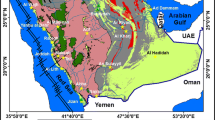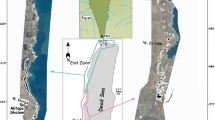Abstract
For about four decades, the Dead Sea (DS) level and the surrounding water table has been dropping dramatically. At least from the eighties, the direct vicinity of the Lisan Peninsula (LP), Jordan, has been facing high rates of subsidence and sinkhole hazards. Between 2000 and 2002, the Arab Potash Company (APC) lost two salt evaporation ponds resulting in a loss of $70 million. In the fertile plain of Ghor al Haditha (GAH), three deep and wide bowl-shaped subsidence areas threaten human activities and infrastructures. Over the part of the Lisan Peninsula that emerged before the 1960s, relict fossil sinkholes occurred everywhere, whereas new collapses constantly appear in the southern area only. In this paper, we have integrated 15 years of field observations related to sinkholes and subsidence with interpretation of space borne radar interferometric outputs, aerial photographs and satellite images. This has helped to place hazardous areas in their geological context and to clarify them within the framework of the general tectonic setting of the area.








Similar content being viewed by others
References
Abelson M, Baer G, Shtivelman V, Wachs D, Raz E, Crouvi O, Kurzon I, Yechieli Y (2003) Collapse-sinkholes and radar interferometry reveal neotectonics concealed within the Dead Sea. Geophy Res Lett 30(10):1545:52-1–52-4
Abou Karaki N (1995) The gravity survey: assessment of the hazard of subsidence and sinkholes in Ghor Al-Haditha area—Final report. In: El-Isa and others, Centre for Consultation, Technical Services and Studies, University of Jordan, (unpublished), pp 117–124
Abou Karaki N (1999) Geoelectrical and precise gravity surveys for the detection of underground cavities in the test zone of Khalifa city site, Abu Dhabi. In: Centre for Consultations Technical Services and Studies, University of Jordan (Done for the Rabah Engineering Laboratories Est., Abu Dhabi, United Arab Emirates)
Al-Zoubi A, ten Brink U.S. (2001) Salt diapir in the Dead Sea and their relationship to Quaternary extensional tectonics. Mar Petrol Geol 18:779–797
Arab Potash Company Limited (2002) Invitation to bid for the re-tender for the execution of remedial works, dike 18, Bid no APC/001/2002
Arieh E, Rotstein Y, Peled U (1982) The Dead Sea earthquake of April 1979. Bull Seismol Soc Am 72(5):1627–1634
Arkin Y, Gilat A (2000) Dead Sea sinkholes—an ever-developing hazard. Environ Geol 39(7):711–722
Baer G, Schattner U, Wachs D, Sandwell D, Wdowinski S, Frydman S (2002) The lowest place on Earth is subsiding—an InSAR (interferometric synthetic aperture radar) perspective. Geol Soc Am Bull 114(1):12–23
Bartov Y, Stein M, Enzel Y, Agnon A, Reches Z (2002) Lake levels and sequence stratigraphy of Lake Lisan, the Late Pleistocene precursor of the Dead Sea. Quat Res 57:9–21
Batayneh AT, Abueladas AA, Moumani KA (2002) Use of ground-penetrating radar for assessment of potential sinkhole conditions: an example from Ghor al Haditha area, Jordan. Environ Geol 41:977–983
Ben-Avraham Z (1997) Geophysical framework of the Dead Sea: structure and tectonics. In : Niemi TM, Ben-Avraham Z, Gat J (eds) The Dead Sea: the lake and its setting. Oxford University Press, Oxford, pp 22–35
Celik M, Asfin M (1998) The role of hydrogeology in solution subsidence development and its environmental impacts; a case study for Sazlica (Nidge, Turkey). Environ Geol 36:335–342
Closson D, Abou Karaki N, Hansen H, Derauw D, Barbier C, Ozer A (2003a) Space-borne radar interferometric mapping of precursory deformations of a dyke collapse—Dead Sea area—Jordan. Int J Remote Sens 24(4):843–849
Closson D, Abou Karaki N, Hussein MJ, Al-Fugha H, Ozer A, Mubarak A (2003b) Subsidence and sinkholes along the Jordanian coast of the Dead Sea: contribution of gravimetry and radar differential interferometry (in French). Compte Rendus Geosci 335(12):869–879
Closson D, Abou Karaki N, Klinger Y, Hussein MJ (2005) Subsidence hazards assessment in the Southern Dead Sea area, Jordan. Pure Appl Geophys (in press)
Cornet Y, Derauw D, Doulliez J-Y, Moxhet J, Closson D, Kourgli A, Ozer A, Ozer P (1998) Interférométrie RSO et analyses géomorphologiques à caractère tectonique en Jordanie. In: Dubois JM, Bernier M, Fortin JP, Boivin F (eds) La réalité de terrain en télédétection: pratiques et méthodes, Série Actualité scientifique (in French). Presse de l’Université du Québec, Sainte-Foy, pp 109–118
Derauw D (1999) Phasimétrie radar à synthèse d’ouverture: théorie et applications (in French). Doctorate, Liege University, Belgium
Dorbath L, Hoffstetter R, Rivera L, Shamir G, Klinger Y (1998) Microseismicity, focal mechanism and stress tensor along the Levantine fault. ESC 98, Tel-Aviv, Israel, 23–28 August, 1998
Frumkin A, Raz E (2001) Collapse and subsidence associated with salt karstification along the Dead Sea. Carb Evapor 16(2):117–130
Gardosh M, Kashai E, Salhov S, Shulman H, Tannenbaum E (1997) Hydrocarbon exploration in the southern Dead Sea area. In: Niemi TM, Ben-Avraham Z, Gat J (eds) The Dead Sea: the lake and its setting. Oxford University Press, Oxford, pp 57–72
Garfunkel Z (1997) The history and formation of the Dead Sea basin. In: Niemi TM, Ben-Avraham Z, Gat J (eds) The Dead Sea: the lake and its setting. Oxford University Press, Oxford, pp 36–55
Garfunkel Z, Zak I, Freund R (1981) Active faulting in the Dead Sea rift. Tectonophysics 80:1–26
Hall JK (1997) Topography and bathymetry of the Dead Sea depression. In: Niemi TM, Ben-Avraham Z, Gat J (eds) The Dead Sea: the lake and its setting. Oxford University Press, Oxford, pp 11–21
Hussein MJ (1997) Gravitational and magnetic study of the Lisan area—southern Dead Sea. MSc Thesis, University of Jordan
Itanar A, Reizman Y (2000) Air photo survey of sinkholes in the Dead Sea area. GSI Curr Res 12:21–24
Jordan Equity Research (JER) (2003) Arab Potash Co. Dead Sea harvest. http://www.atlasinvest.net/html/research/equity_reports/ EquityResearch-APOT_En.pdf, 13 pp
Klinger Y (1999) Sismotectonique de la faille du Levant. Université Louis Pasteur, Strasbourg, France. 238 pages (see chapter 5, pp 163–205)
Knight DJ (1993) Extension west of Lisan Peninsular sinkholes along access road. The Arab Potash Company, DJK/A110/92235B, unpublished report. 16 pp
Map-1: “The salt upwarp of El Lisan”. After geophysical and drilling by Phillips Petrol Co. 1960/1961; Seism. Survey ARGAS 1967; Drilling by NRA 1967/1968 and 1987/1988; Geophys. By INOC 1985; Compiled by Bender 1967, Abu-Ajamieh 1987b
Map-2: “Dead Sea geophysical survey—bathymetric chart”. Compiled by John K. Hall - 1:1000000 - Jerusalem: Geological survey of Israel, 1979
Neev D (1964) The Dead Sea. Geological Survey of Israel, report Q/2/64. 407 pp
Neev D, Emery KO (1967) The Dead Sea—Depositional processes and environments of evaporates. Geol Surv Israel Bull 41:1–147
Niemi TM, Ben-Avraham Z (1997) Active tectonics in the Dead Sea basin. In: Niemi TM, Ben-Avraham Z, Gat J (eds) The Dead Sea: the lake and its setting. Oxford University Press, Oxford, pp 73–87
Quennell A (1958) The structural and geomorphic evolution of the Dead Sea rift. Q J Geol Soc Lond 114:1–24
Sagy A, Reches Z, Agno A (2003) Hierarchic three-dimensional structure and slip partitioning in the western Dead Sea pull-apart. Tectonic 22(1):4/1–4/17
Salameh E, Abu Naseir T (1999) The quantitative and qualitative impacts of the rehabilitation of the municipal water supply network on the groundwater resources in Amman area, Jordan. J Hydrogeol Environ 18:189–197
Salameh E, El-Naser H (1999) Does the actual drop in Dead Sea level reflect the development of water sources within its drainage basin? Acta Hydrochem Hydrobiol 27:5–11
Salameh E, El-Naser H (2000a) Changes in the Dead Sea level and their impacts on the surrounding groundwater bodies. Acta Hydrochem Hydrobiol 28:2–33
Salameh E, El-Naser H (2000b) The interface configuration of the fresh-/Dead Sea water–theory and measurements. Acta Hydrochem Hydrobiol 28(6):323–328
Shimoni M, Hanssen RF, Van Der Meer F, Kampes BM, Ben Dor E (2002) Salt diapir movements using SAR interferometry in the Lisan Peninsula, Dead Sea rift. Proceedings of SPIE 4543, pp151–160
Sunna BF (1986) The geology of salt deposits in the Lisan Peninsula, Dead Sea. Seminar on salt in the Arab world, Ministry of Energy and Mineral Resources, NRA, Amman – Jordan, 4–6 May
Tapponnier P (1993) Collapse hazard near projected dyke west Lisan Peninsula, Dead Sea. The Arab Potash Company Project, unpublished report, 19 pp
Taquieddin SA, Abderahman NS, Attalah M (2000) Sinkhole hazards along the eastern Dead Sea shoreline area, Jordan: a geological and geotechnical consideration. Environ Geol 39(11):1237–1253
Yiechieli Y, Wachs D, Abelson M, Crouvi O, Shtivelman V, Raz E, Baer G (2003) Formation of sinkholes along the shore of the Dead Sea; summary of the first stage of investigation. Proceeding of the 9th multidisciplinary conference “Sinkhole and the engineering and environmental impacts of karst”, pp 184–494
Acknowledgements
Thanks are due to Prof. Najib Abou Karaki from the University of Jordan for fruitful discussions, photographic documents and critical reading of the manuscript. We used astronaut photographs of Earth acquired on 2003–02–23 (ISS006-E-30989; ISS006-E-30990; ISS006-E-30991; ISS006-E-30992; ISS006-E-30993; ISS006-E-30994) and on 2002–02 (STS099–705–4). Images are courtesy of Earth Sciences and Image Analysis Laboratory, NASA Johnson Space Center. (http://eol.jsc.nasa.gov). The Royal Military Academy of Belgium supports the author’s work.
Author information
Authors and Affiliations
Corresponding author
Rights and permissions
About this article
Cite this article
Closson, D. Structural control of sinkholes and subsidence hazards along the Jordanian Dead Sea coast. Env Geol 47, 290–301 (2005). https://doi.org/10.1007/s00254-004-1155-4
Received:
Accepted:
Published:
Issue Date:
DOI: https://doi.org/10.1007/s00254-004-1155-4




